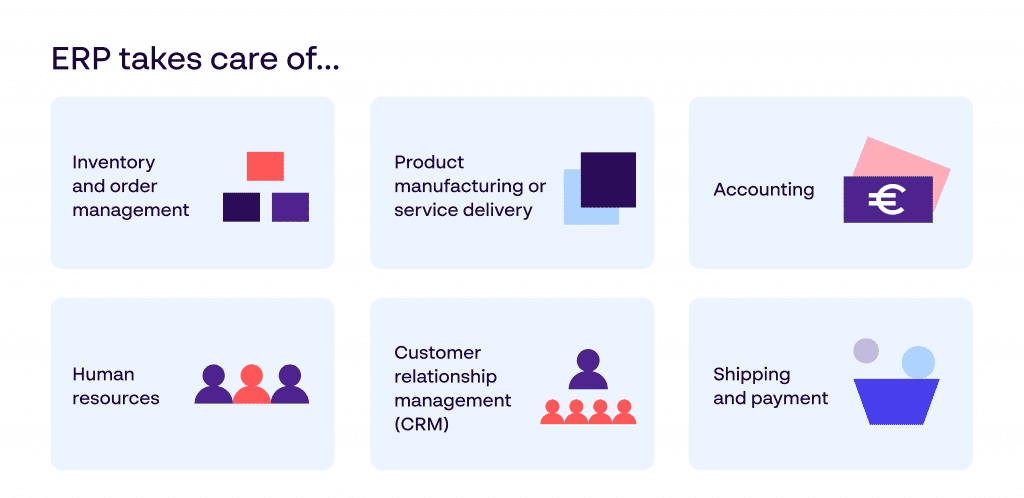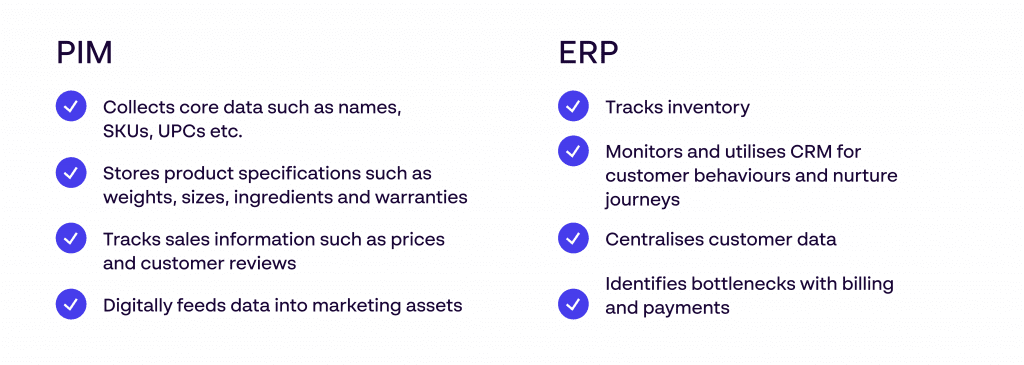One of the prevailing problems that face retailers is juggling the vast quantities of data, processes and software that keep their business running day-to-day. Whether it’s tracking product codes and prices or compiling the array of CRM, BI, inventory management and other systems, maintaining all of this information used to be a monumental task.
Now, thanks to the introduction and evolution of PIM (Product Information Management) and ERP (Enterprise Resource Planning) integration, this challenge has become far less daunting.
These systems are designed to help retailers control and manage their extensive streams of data in one central location, much in the same way BAM by Papirfly™ does for the components behind our clients’ brands. However, both PIM systems and ERP systems (and their many benefits) are still not universally adopted or even known by all retailers.
So, we wanted to use this article as an opportunity to spread the word about these useful systems, what advantages they lend to both the customer experience and your marketing efforts, and how a PIM, an ERP and BAM combine to make a real difference in the world of retail.
What is PIM?
PIM stands for Product Information Management, and represents systems designed to collect and store all of the data, content and additional materials needed to market and sell products. This includes but is not limited to:
- Core data such as names, SKUs, UPCs, product descriptions, etc.
- Product specifications including weights, sizes, ingredients, warranties, etc.
- Sales information, including prices and customer reviews
- Digital assets that support the product, such as imagery, videos and documents
- Marketing information such as SEO elements, keywords, customer personas, etc.
As you can imagine, prior to the rise of the Internet this would be contained in reams of paper files that were difficult to keep in order or sort through. Even when these were transferred onto spreadsheets, managing these thousands upon millions of pieces of data could again prove unwieldy.
Once this data is housed within a PIM system like Akeneo or Plytix, it can then be translated into the various channels and formats required for smooth operation, such as:
- E-commerce listings
- Online marketplaces
- Product sheets and point of sale material
- Product catalogues and brochures
- Product labelling
A PIM system therefore acts as a means to centralise all of this information in one place so that those who need access to this data, including sales teams, e-commerce managers, and marketers have it to hand so they can then feed it through to your customers.

What is ERP?
ERP, or Enterprise Resource Planning, captures all of the processes and systems that are essential for a business to run. As such, ERP systems can find a welcome home in any organisation due to the volume of procedures, software and other elements that go into making them tick, especially in today’s landscape.
But they have become increasingly valued in the world of retail as the means to centrally manage all of the moving parts that typically take place within this industry, including:
- Inventory and order management
- Product manufacturing or service delivery
- Accounting
- Human resources
- Customer relationship management (CRM)
- Shipping and payment
- Campaign planning
At a fundamental level, an ERP houses all of these systems in order to support and streamline the flow of information across an organisation. That helps ensure that everyone understands the structure and processes behind the business, minimising the risk of mistakes and allowing each action to flow seamlessly into one another.
This means:
- Greater compliance across all necessary regulatory standards
- Opportunities to automate core business functions
- A real-time oversight over the data driving your company
- A single source for billing and relationship tracking, boosting your customer experience
ERP integration isn’t necessarily something a small retailer will immediately consider. But once they expand into multiple locations nationally or internationally, and especially for global retailers, having this central source of truth for the various tools and processes that underline your business can be a huge support in things running smoothly.

How does PIM/ERP integration benefit customer experience and marketing?
In order to most effectively and efficiently demonstrate the advantages offered by PIM and ERP integration, we’ve honed in on two of the most important factors for retailers:
- Customer experience
- Marketing
Meeting the ever-changing demands of increasingly tech-savvy and observant customers is a persistent challenge for all retailers. With more and more priority being placed on delivering a united omnichannel experience for customers, retailers need the tools at their disposal to provide this to build customer loyalty and secure a competitive edge.
Both PIM and ERP systems can play a key role in supporting your efforts to nail your customer experience and enhance the quality and consistency of your retail marketing. Starting with PIM integration, having a central repository for all your product-related data is vital to ensuring customers receive all the information they’re searching for across your channels.
Without a PIM, there is a greater margin of error that product data, labels and more become misplaced or disorganised. This can subsequently clutter your customer’s experience on your various platforms, and could cause you to present inaccurate information in marketing or promotional material, which would damage trust if you need to retract anything.
A PIM helps keep all this data in check and up-to-date, to ensure marketers have the resources they need to deliver accurate, rich content, and that customers have all the information they need to make an informed purchase. Furthermore, using a PIM can help with:
- Providing relevant reviews and testimonials to inspire confidence in your customers towards your products, as well as the data to write more compelling descriptions
- Guaranteeing uniformity across your product descriptions and layouts so customers do not become confused or overwhelmed across your various channels
- Immediately adjusting product information on all channels and linking this to automated messages or emails to ensure your audience is always in the loop
- Optimising time-to-market by giving your product data more structure, giving your marketers access to key info that they can turn around to your audiences
By establishing a single source of truth for everything related to your product, you are able to ensure that your teams always have the freshest and most relevant data. This means customers are never fed incorrect or out-of-date information, you can give them rich, optimised content across multiple channels.
As for ERP integration, because this helps ensure your business operations are never fragmented, it makes the path from a product arriving in your possession to displaying it for your audience clear and digestible.
While your process might vary from another retailer, the only thing that matters is you know and understand your approach. An ERP achieves this and keeps critical information up-to-date to support the efforts of your marketing and sales teams, who then can work their magic to engage your customers.
ERP integration works to:
- Track inventory across your business, so your marketers and customers can be immediately informed if an item is out of stock
- Monitor and utilise your CRM to identify any changes in customer behaviours and nurture journeys across all channels
- Consolidate all customer information in one central location, which can help ensure compliance over data use and present opportunities to provide personalised marketing
- Identify bottlenecks relating to billing and payment processes for customers, so they can navigate this process and you know when to offer support when required
If you already employ an ERP and use it for campaign planning, Papirfly can deliver an effective integration point that seamlessly picks up this information and combines it with the data in a PIM. This means more than just a birds-eye view of planned campaigns, but an up-to-date list of all associated products. In other words, our software aggregates data from multiple sources.
This can be further enriched with campaign-specific details, including relevant messaging, colours, graphics and pricing. Plus, this can all be directly accessed from templates, so there is no need to manually transfer any information from the campaign planning process, master data management, pricing or DAM.
Contrast this with retailers without an ERP or similar planning system. They will often have to resort to multiple spreadsheets for campaign planning and, in a worst-case scenario, pricing, master data and digital assets are shared manually. This is not only time-consuming but opens up the potential for human error, meaning more time must be spent on briefing and proofing.
Fundamentally, by bringing your core data, processes and software under one unified roof, both PIM and ERP systems can play a huge factor in supplying your marketing teams with rich, real-time information, and supporting your customers’ interaction with your business.
When your business and your product/customer-related data are streamlined and centralised, you’ll find your ability to meet customer expectations is enhanced like never before.

BAM by Papirfly™ and PIM/ERP integration
Now that you hopefully have a stronger understanding of the power PIM and ERP systems offer your marketing output and customer experience, let’s ramp this up even further by introducing Brand Activation Management (BAM).
In several ways, BAM software fulfils a similar role as PIM and ERP solutions in that it is about removing inconsistencies, mistakes and bottlenecks, and providing a single source of truth to empower retailers. But, while a PIM’s focus is on products and ERPs cover your business operations, BAM’s priority is unlocking the full potential of your brand.
Due to the strong synergy between these three standout solutions, we have designed our BAM solution to fully integrate with our clients’ PIM and ERP systems. By doing this, it cuts out any need for a middleman to transition the quality data within these systems into your marketing and promotional material – it can now be accessed automatically, leaving no margin for error.
This allows retailers to:
- Use their PIM data to enrich the content behind every product and promotion, supporting your customers with their enquiries
- Seamlessly update cost information and stock levels so customers are always provided with the most accurate details
- Respond swiftly to seasonal and local trends with a wide range of content-rich, precise digital and printed materials
Furthermore, campaigns can also be planned within BAM, with the ability to add products and edit these manually if necessary. Wherever the retailer is on their journey to streamline their operations, Papirfly can help.
If you have already taken strides to optimise and secure your product data and business processes, and would like to do the same to your branding, we’re here to help you unlock its true potential.
BAM empowers your team with the ability to create high-quality assets across all channels without specialist support, while simultaneously providing a central space for all your approved collateral, imagery and brand guidelines. This means everyone in your organisation has access to the materials they need to enhance your brand and keep things consistent.
Get in touch with our friendly team if you’d like to learn more.
